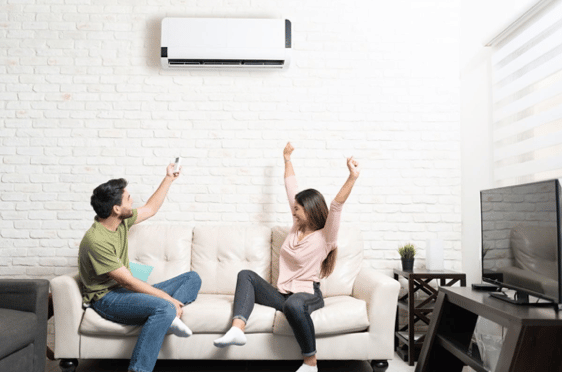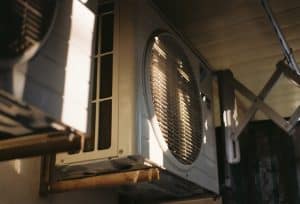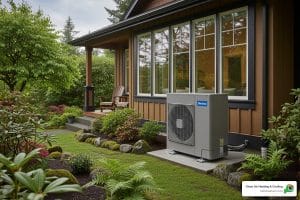Did you know that according to the U.S. Department of Energy, the average American household spends about $2,000 a year on energy bills? And of that, heating and cooling account for nearly half of the total! That’s why it’s so important to choose the right HVAC system for your home- one that will be efficient and effective in keeping your home comfortable all year round.
When it comes to HVAC systems, mini-splits are becoming increasingly popular due to their many advantages over traditional systems. But when you’re ready to invest in a mini-split system, the most important thing to consider is what size unit you need. A properly sized unit will ensure efficient and comfortable heating and cooling all year round.
In this article, we’ll guide you through the process of choosing the perfect mini-split for your needs. We’ll cover the basics of how mini-split air conditioners work, what factors you need to consider for mini split sizing, and what to look for when shopping for a mini-split. By the end, you’ll have all the information you need to choose the perfect mini-split for your home.
What Is a Mini-Split?

A mini-split is a type of HVAC system that doesn’t require ductwork. Instead, it uses an outdoor compressor unit connected to one or more indoor air-handling units. The indoor and outdoor unit is connected by small refrigerant lines, which carry the cool air from the compressor to the air handler unit.
The main advantages of mini-splits over traditional systems are their energy efficiency, flexibility, and low cost. Since mini-split installations don’t require ductwork or professional HVAC installation, they’re also much easier to install than traditional systems.
How Does A Mini-Split Work?
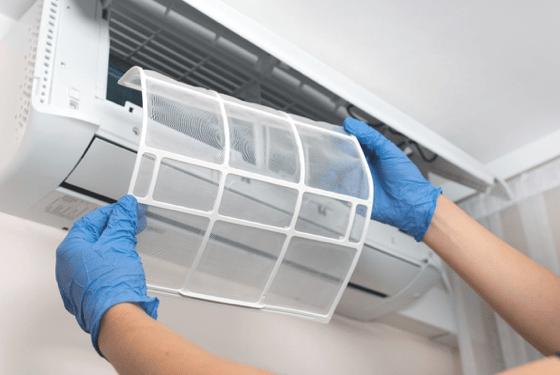
Mini-splits work by drawing hot air out of your home and pumping cool air in. During the heating season, the system draws warm air from inside your house and transfers it to the outside unit using a heat exchanger. The outgoing air is used to warm refrigerant which pumps cold liquid into the indoor unit.
During times when the indoor air is cooler than the outside, the process runs in reverse. The system draws hot air from outside and moves it inside through a condenser coil. A compressor then increases the pressure of this liquid refrigerant until it becomes a gas.
The cooled, pressurized refrigerant enters an evaporator coil within the indoor unit and cools down your home. This refrigerant is then pumped back to the outdoor unit and goes through the cycle over again.
What Sizes of Mini-Splits Are Available?

When it comes to mini-splits, there are two main sizing options: single-zone and multi-zone. Single zone units cover a single room or living space, while multi-zone units can be used for more than one area of your home.
Most mini-split systems have cooling capacities that range from 9,000 to 36,000 British thermal units (BTUs). The specific cooling capacity you need will depend on a number of factors, which we’ll discuss in more detail below.
Sizing Chart as per Your Needs
- 200 sq. ft. area: 6,000 BTUs
- 400 sq. ft. area: 9,000 BTUs
- 700 sq. ft. area: 14,000 BTUs
- 800 sq. ft. area: 18,000 BTUs
- 900 sq. ft. area: 18,000 BTUs
- 1000 sq. ft. area: 21,000 BTUs
- 1500 sq. ft. area: 23,000 BTUs
- 2000 sq. ft. area: 24,000 BTUs
What Factors Should I Consider When Sizing My Mini-Split?
When choosing the mini split size, there are three main factors you need to consider: square footage, insulation, and internal load.
1. Square footage.
How large is the room or areas of your home you want to cool or heat? Keep in mind that most mini-split systems are rated for heating and cooling spaces up to 325 square feet, although there are many larger units available as well.
2. Insulation.
The level of insulation in your home can directly impact the size of an indoor unit you need. If your home is well insulated, you’ll need a smaller unit to heat or cool the same amount of space as a home with poor insulation.
3. Internal load.
The internal load is the heat generated by people and appliances inside the room or area you’re trying to cool or heat. This heat can come from things like lights, computers, and cooking appliances. The more heat generating devices you have in a space, the higher the internal load and the larger the mini-split AC you’ll need to compensate for it.
How Do I Choose the Right Size Mini-Split for My Home?
Now that you know what factors to consider when sizing a mini-split, it’s time to choose the right unit for your needs. To do this, follow these steps:
1. Determine the square footage of the room or area you want to heat or cool.
First, you’ll need to know the square footage of the room or area you want to heat or cool. This will help you determine what capacity unit you need. To find the square footage, simply multiply the length and width of the room or area in question.
2. Use a BTU calculator to find out how many BTUs per hour you’ll need.
Next, you’ll need to use a BTU calculator to determine how many BTUs per hour you’ll need. You can find one online by simply doing a quick Google search; there are plenty available.
To do this, you’ll need to input a few pieces of information, such as the square footage of the room or area, the number of people who typically occupy it, the climate (hot, cold, etc.), and more. Once you have all this information entered, the calculator will give you a rough estimate of how many BTUs per hour you’ll need.
3. Choose a mini-split unit with the appropriate BTU output.
Now that you know how many BTUs per hour you need, you can choose a ductless mini-split unit with the appropriate BTU output. Most units range from about 9,000 to 36,000 BTUs, so there’s sure to be one that’s perfect for your needs.
However, it’s important to note that the size of the unit is not the only factor you should consider. You’ll also need to take into account the climate, the number of people who typically occupy the space, and other factors.
4. Talk to a professional to help you choose the right size unit.
If you still have questions or need further guidance, it’s always a good idea to consult with a professional. A reputable HVAC service can help you determine exactly what size unit you need and install it for you as well. With their help, you’ll be able to get the perfect mini-split for your needs and ensure that it’s installed properly.
5. Follow the manufacturer’s recommendations.
Finally, it’s important to follow the manufacturer’s recommendations when choosing a mini-split unit. They’ll have specific sizing recommendations based on the square footage, internal load, and other factors. By following this advice, you can be sure that your mini-split will be properly sized and effective.
Why Right Size is Important?
As we’ve discussed, it’s important to choose the right size mini-split for your needs. A properly sized unit will be more efficient and provide better heating and cooling all year round. Additionally, a properly sized unit is less likely to break down or require repairs.
On the other hand, if you do not choose the right size unit, you could end up with the following critical issues:
1. Overheating.
If your mini-split air conditioner is too large for the space you’re trying to heat or cool, it may end up overheating and breaking down. This can lead to costly repairs, not to mention uncomfortable indoor temperatures.
2. Underheating or undercooling.
A mini-split that’s too small for a space will have difficulty heating or cooling it properly. This can leave you feeling uncomfortably warm in the summer and cold in the winter.
3. Higher energy bills.
A mini-split that’s the wrong size for a space is also less efficient, which means it will use more energy and end up costing you more money on your energy bills.
4. Premature system failure.
A mini-split that’s too small or large for your needs is also more likely to experience premature system failure. This can mean costly repairs and even having to replace the entire unit altogether.
5. Increased risk of mold and other air quality issues.
Finally, an improperly sized mini-split is also more likely to cause health problems like asthma and allergies. This is because it will not be able to filter and properly circulate air in your home, which can lead to mold growth and other air quality issues.
As you can see, choosing the right size mini-split is critically important for a number of reasons. With that in mind, it’s always best to consult with a professional to ensure you’re choosing the perfect unit for your needs.
Final Words
As you can see, it’s important to choose the right size mini-split for your needs. A properly sized unit will be more efficient, provide better heating and cooling, and last longer. So, take the time to find the perfect unit for your space, and be sure to consult with a professional if you have any questions.
With their help, you can get the perfect mini-split air conditioner for your home and enjoy comfortable temperatures all year round.
Need Help with Mini-Split Installation?
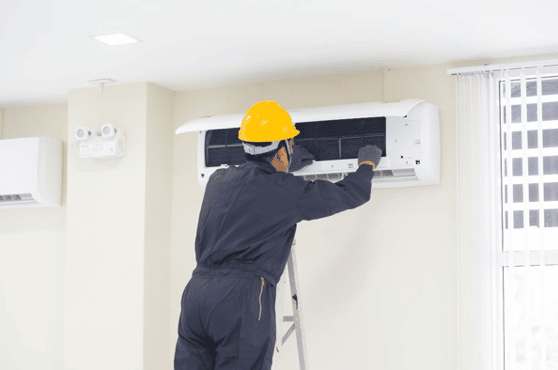
If you’re in need of a mini-split installation, be sure to call the professionals at CleanAir. We have years of experience installing and servicing mini-split systems, and we’ll make sure your unit is installed properly and functioning correctly. Contact us today for a free quote!
FAQs
How do I know what size mini-split I need?
The size of the mini-split system you’ll need depends on a variety of factors, such as the size and layout of your home, the number of windows and doors, the insulation in your home, and the climate.
How many square feet will a 12 000 BTU Mini Split cool?
A 12000 BTU mini split can cool approximately 400-500 square feet.
Is it OK to oversize a mini-split?
It is okay to oversize slightly, but it is not necessary and could result in higher energy bills. If you have any questions about sizing, consult a professional HVAC contractor.
How many square feet will a 24000 BTU mini-split heat?
A 24000 mini split BTU can effectively heat up to 1000-1200 square feet, depending on a variety of factors such as insulation levels and climate.
What size mini-split do I need for a skoolie?
If you are converting a school bus or RV into a living space, you will likely need a larger mini-split system than the average home. A 24000 BTU unit should be sufficient for most skoolies, although you may want to consult with an HVAC professional to determine the specific requirements for your space.
What size BTU Mini Split do I need?
The size of BTU that you need depends on many different factors, including the size and layout of your home, the number of windows and doors, the insulation in your home, and the climate.
How many BTU do I need for a 12×12 room?
For a 12×12 room, you will need approximately 1000-1200 BTUs.
How many BTU do I need for a 20×20 room?
For a 20×20 room, you will need approximately 2000-2400 BTUs.
What size room will a 12000 BTU air conditioner cool?
A 12000 BTU air conditioner can effectively cool a 400-500 square foot space.
Is it better to oversize or undersize a mini-split?
It is usually better to slightly undersize a mini-split than to oversize it, as an oversized unit will often result in higher energy bills. If you have any questions about sizing, consult a professional HVAC contractor.
How many sq ft will a 2 ton mini split cool?
A 2 ton mini split can effectively cool 1000-1200 square feet.
How many square feet will a 36000 BTU Mini Split cool?
A 36000 BTU Mini Split can effectively cool 2000-2400 square feet.
What size mini-split for the garage?
The size of mini-split you need for your garage will depend on the size and layout of your space, as well as other factors such as the climate and insulation levels. To find the right unit for your garage, it’s best to consult with a professional HVAC contractor.
What size mini-split for a 24×24 garage?
For a 24×24 garage, you will likely need at least 2000-2400 BTUs. To determine the exact size of unit needed, it’s best to consult with a professional HVAC contractor.
What size mini-split for 2 car garage?
For a 2 car garage, you will likely need at least 2000-2400 BTUs. To determine the exact size of unit needed, it’s best to consult with a professional HVAC contractor.

